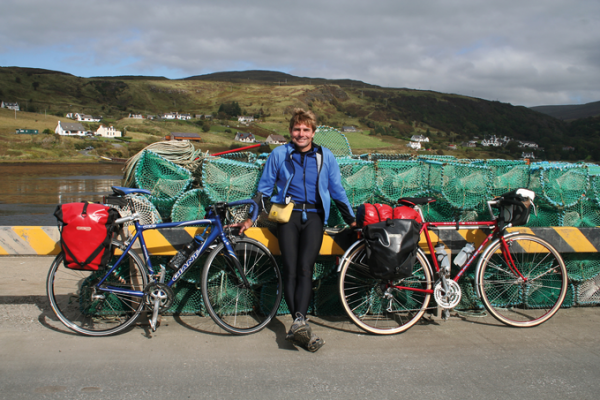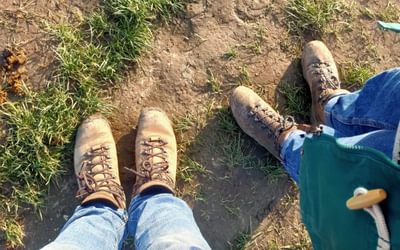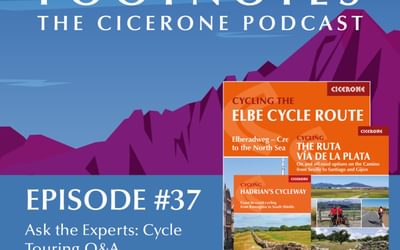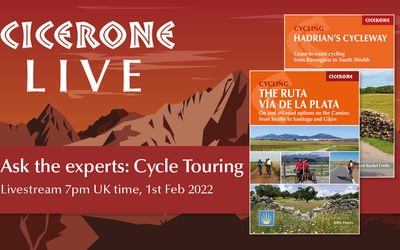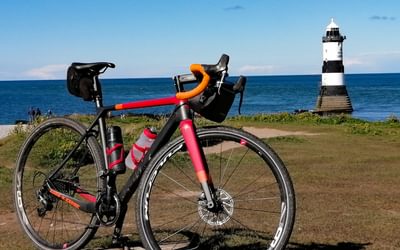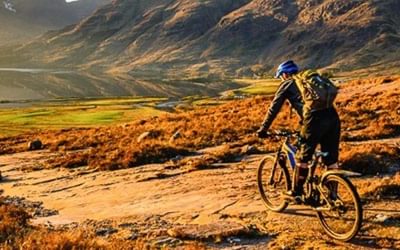What is the best bike for cycle touring?
Cycle touring is a brilliant activity for people of all ages and most levels of fitness. In this blog post, Cicerone Press author Richard Barrett explains what, in his opinion, is the best bike for cycle touring.
Many types of bike can be adapted for cycle touring
What type of bike is best for cycle touring?
Without wanting to offend the fans of tandems, tricycles, and folding and recumbent cycles, there are broadly three types of bike and all are suitable for the routes in my book. However, there are some things that you can do to make your rides more comfortable.
Road bikes
Touring bikes are usually made out of steel and have a longer frame than a normal road bike. This makes them springy and allows you to stretch out more. But there is nothing wrong with using a road bike for touring and all you really need to do is add a rack and fit the widest tyres that your wheel rims and frame clearance will allow. Most ‘roadies’ ride on 23mm tyres but moving up to 25mm or 28mm tyres will give that extra bit of comfort and leave you less prone to punctures.
If your bike does not have threaded braze-ons, you will need to use a rack that clamps on to an alloy seat post. This is entirely adequate for lightweight ‘credit-card’ touring, but if you are riding a bike with a carbon frame, you are probably best to try to go ultra-lightweight and limit yourself to a single rack bag. And don’t even think about clamping a rack to a carbon seat post. Buy a cheap alloy one instead.
City bikes
The only difference between road bikes and city bikes is normally the quality of the fittings and that most city bikes have flat handlebars. So in addition to fitting wider tyres, many people fit bar ends or even butterfly bars to give more choice in resting tired hands.
Mountain bikes
It is also worth considering fitting bar ends or butterfly bars to a mountain bike – and if your bike has full suspension you may need to fit the type of rack that clamps on to the seat tube. You might want to consider changing the knobbly tyres for lower profile urban tyres which have less rolling resistance giving a far quieter ride. Locking off the suspension will also waste less energy when riding on good tarmac roads.
Tyres
Cycle tyres are classified by their diameter measured in centimeters, ranging from the skinny 23mm tyres used on racing bikes, through the 30–40mm tyres preferred by cycle tourists, to the larger diameters used on mountain bikes. My personal preference for riding and light-weight touring in the Hebrides are puncture-resistant touring tyres, with a 25mm on the front and a 28mm on the rear.
The views can be enjoyed as quickly or slowly as you like
Unless the gears on your bike are suitable for the terrain you will be riding, you will find yourself struggling up any hills. It is always better to have a low gear in reserve than a high gear you never use and typically this means having a back sprocket with the same number of teeth as the front largest chain ring. If you explain where you are going to the folk at your local bike shop and tell them about the biggest climb you are likely to encounter, they will be able to fit any gears you need.
It is always advisable to have your bike serviced a couple of weeks before your trip, allowing sufficient time for any worn parts to be replaced and run-in before your departure. Some people will have the knowledge and tools to do this themselves, otherwise your local bike shop will be happy to do this for you.
- Pre-trip bike check Wheels should run smoothly and show no signs of buckling. Check to see if there is any side-to-side play in the hubs or any missing or slack spokes.
- Tyres should be in good condition with plenty of tread left on them and no signs of weathering or weaknesses in the walls. They should also be inflated to the pressure recommended by the manufacturer as the less rubber there is in contact with the road, the easier it will be to pedal.
- Brakes should be effective with plenty of wear left on the brake blocks and room remaining for adjustment in the tension of the cables, which should move smoothly and not show any signs of kinking or undue wear.
- Pedals and crankshaft should turn smoothly without any play in the axle.
- Gears should change smoothly and silently without the chain overriding the chain rings or sprockets when selecting high or low gears.
- All fixing nuts and bolts on mudguards and carriers should all be tight.
- Even if there is nothing obviously wrong with your bike, apply oil to the chain and gears, check for loose spokes and excess play in brake and gear cables and have a short ride to make a final check that it’s in tip-top condition before you leave home.
Finally, and most important - have a safe and enjoyable trip!
To read more please see Richard Barrett's guide to Cycling in the Hebrides, published by Cicerone Press.
Cycling in the Hebrides
Island touring and day rides including The Hebridean Way
£14.95
Cycling in the Hebrides is a comprehensive guidebook of routes, day rides and suggested island cycle tours throughout the Inner and Outer Hebrides and the Firth of Clyde with ferry schedules and timings. Routes range from rides suitable for a weekend break to a challenging 600 mile tour covering the entire region.
More informationTo read more articles like this get our newsletter
Sign up for 20% off your next purchase and to be the first to hear about exclusive competitions, special offers, and news from Cicerone.


